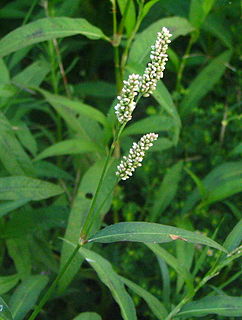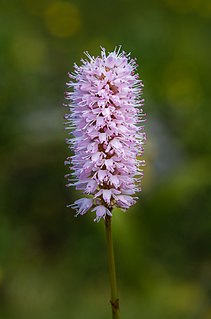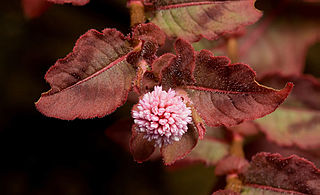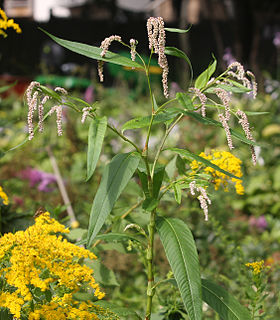
The Polygonaceae are a family of flowering plants known informally as the knotweed family or smartweed—buckwheat family in the United States. The name is based on the genus Polygonum, and was first used by Antoine Laurent de Jussieu in 1789 in his book, Genera Plantarum. The name may refer to the many swollen nodes the stems of some species have, being derived from Greek, poly meaning 'many' and gony meaning 'knee' or 'joint'. Alternatively, it may have a different derivation, meaning 'many seeds'.

Bistorta officinalis, known as bistort, common bistort, European bistort or meadow bistort, is a species of flowering plant in the dock family Polygonaceae native to Europe and northern and western Asia. Other common names include snakeroot, snake-root, snakeweed and Easter-ledges.

Persicaria is a genus of herbaceous flowering plants in the knotweed family, Polygonaceae. Plants of the genus are known commonly as knotweeds or smartweeds. It has a cosmopolitan distribution, with species occurring nearly worldwide. The genus was segregated from Polygonum.

Polygonum is a genus of about 130 species of flowering plant in the buckwheat and knotweed family Polygonaceae. Common names include knotweed and knotgrass. In the Middle English glossary of herbs Alphita, it was known as ars-smerte. There have been various opinions about how broadly the genus should be defined. For example, buckwheat has sometimes been included in the genus as Polygonum fagopyrum. Former genera such as Polygonella have been subsumed into Polygonum; other genera have been split off.

Persicaria maculosa is an annual plant in the buckwheat family, Polygonaceae. Common names include lady's thumb, spotted lady's thumb, Jesusplant, and redshank. It is widespread across Eurasia from Iceland south to Portugal and east to Japan. It is also present as an introduced and invasive species in North America, where it was first noted in the Great Lakes region in 1843 and has now spread through most of the continent.

Bistorta vivipara is a perennial herbaceous flowering plant in the knotweed and buckwheat family Polygonaceae, commonly known as alpine bistort. Scientific synonyms include Bistorta vivipara and Polygonum viviparum. It is common all over the high Arctic through Europe, North America, and temperate and tropical Asia. Its range stretches further south in high mountainous areas such as the Alps, Carpathians, Pyrenees, Caucasus, and the Tibetan Plateau.

Persicaria lapathifolia, known as pale persicaria, is a plant of the family Polygonaceae. It is closely related to Persicaria maculosa and as such is considered a weed in Britain and Europe. Other common names for the plant include pale smartweed, curlytop knotweed, and willow weed. It is a species complex made up of a great many varying forms, sometimes considered varieties. The environment also has a strong influence on the morphology of an individual plant.
In biological nomenclature, a nomen novum, new replacement name is a technical term. It indicates a scientific name that is created specifically to replace another scientific name, but only when this other name cannot be used for technical, nomenclatural reasons ; it does not apply when a name is changed for taxonomic reasons. It is frequently abbreviated, e.g.nomen nov., nom. nov..

Persicaria filiformis is a species of flowering plant in the family Polygonaceae, native to the Kuril Islands, Japan, Korea, Myanmar, the Philippines and Vietnam. It was first described as Polygonum filiforme in 1784 by Carl Thunberg and transferred to the genus Persicaria in 1819 by Takenoshin Nakai. The species has been treated as the variety filiformis of Persicaria virginiana, a North American species.
Persicaria cespitosa, known as tufted knotweed, is a summer annual weedy plant of the family Polygonaceae, native to eastern Asia, from China to Japan and Southeast Asia, and introduced into North America. The plant grows to 3.5 feet (105 cm) in height with elliptic to lanceolate leaves, usually 20–75 mm long. It has small pink or red flowers arranged in tight terminal spikes.

Bistorta is a genus of flowering plants in the family Polygonaceae. As of February 2019 about 40 species are accepted. It has been supported as a separate clade by molecular phylogenetic analysis. Bistorta species are native throughout much of the Northern Hemisphere, as far south as Mexico in North America and Thailand in Asia.
Persicaria posumbu is a species of flowering plant in the family Polygonaceae. It was first described as Polygonum posumbu in 1825 and transferred to the genus Persicaria in 1919. Plants of the World Online records it as having a discontinuous native distribution: the Assam region, Bangladesh and the eastern Himalayas to the west, and Japan, Korea, the Kuril Islands and Primorye to the east.
Polygonum rupestreKar. & Kir. is a species of flowering plant in the family Polygonaceae, native to Kazakhstan, Kyrgyzstan, Tajikistan and Uzbekistan. It was first described by Grigorij Silych Karelin and Ivan Kirilov in 1841.
Daniel Atha is a botanist. In his work as a botanist he has collected plants in all 50 states of the United States of America, as well as several additional countries. Atha's work is focused on three areas: "floristics—what plants grow in a particular region; taxonomy—how to tell one plant from another, what to call it and what it's related to; and applied botany—how plants are used for food, medicine, shelter and other useful purposes." Atha is a prominent regional botanist, and the high-profile botanical projects with which has been involved have garnered national and international attention.

Polygonum ciliinode is a species of flowering plant in the family Polygonaceae, native to central and eastern Canada, and the north-central and eastern United States. The specific epithet is also spelt cilinode.

Persicaria nepalensis is a species of flowering plant in the family Polygonaceae, native to eastern Africa, including Madagascar, and parts of Asia. It has been introduced elsewhere: parts of Europe, North America and northern South America. The species was first described as Polygonum nepalense by Carl Meissner in 1826, and transferred to Persicaria by Hugo Gross in 1913.

Persicaria orientalis is a species of flowering plant in the family Polygonaceae, known as kiss-me-over-the-garden-gate and princess-feather. It was first described, as Polygonum orientale, by Carl Linnaeus in 1753. It was transferred to the genus Persicaria by Édouard Spach in 1841. Its native distribution is unclear. As of May 2019, Plants of the World Online lists only Uzbekistan, whereas other sources give a much wider distribution in temperate and tropical Asia and Australia. It is widely cultivated and naturalized.

Persicaria runcinata is a species of flowering plant in the family Polygonaceae, native to the eastern Himalayas and Myanmar. It was first described in 1825 as Polygonum runcinata.
Persicaria bungeana is a herbaceous annual, flowering plant species in the family Polygonaceae. Commonly known as prickly smartweed or Bunge's smartweed, it is a weed found in soybean fields of the Mid-Western United States of America.

Persicaria prostrata, basionym Polygonum prostratum, is a species of flowering plant in the family Polygonaceae, native to Australia and perhaps New Zealand. It is known by the common name of creeping knotweed.














